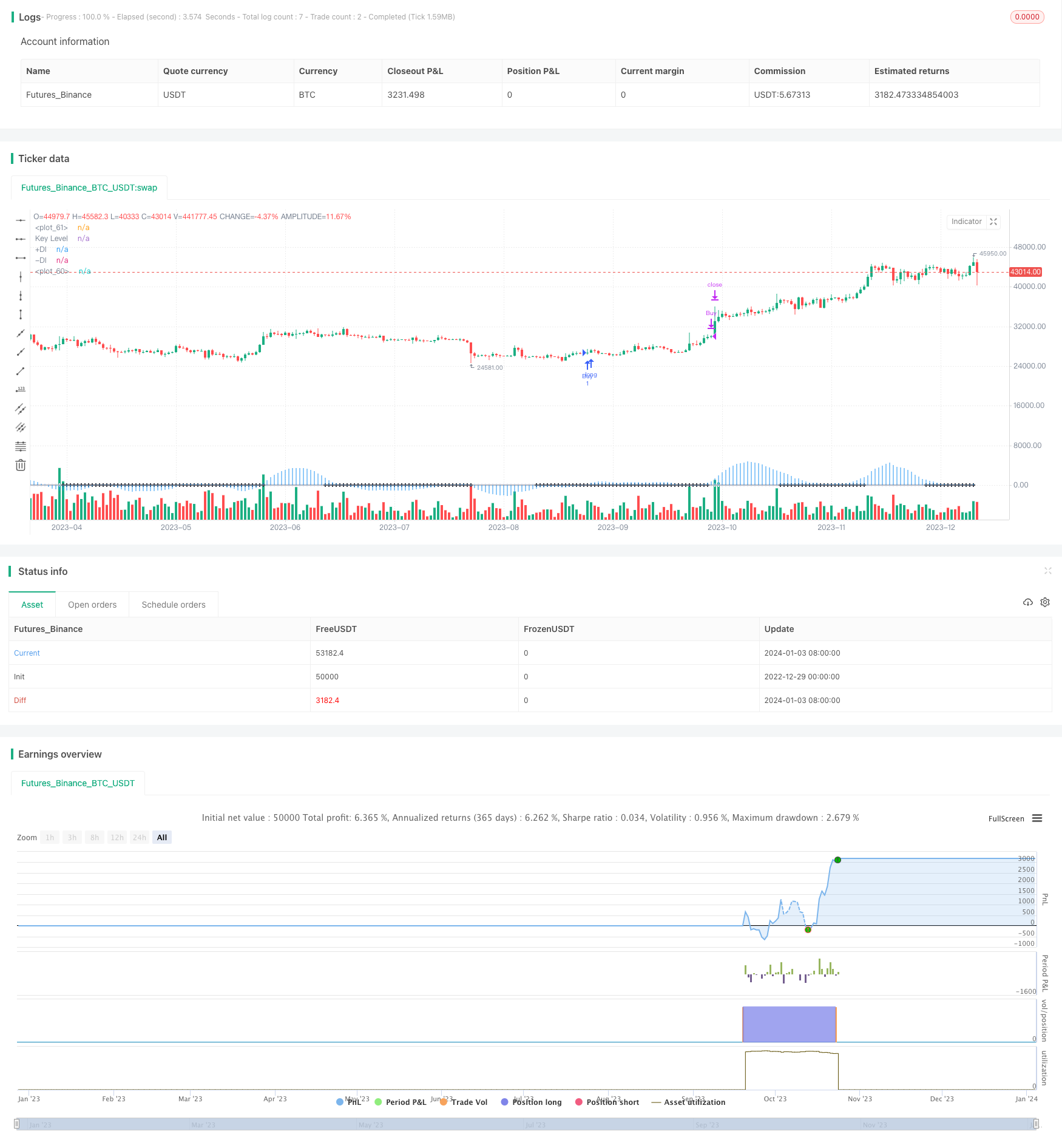
概述
该策略是一个基于动量指标的自适应股票交易策略。它整合了布林带、Keltner通道和价格压缩指标,实现了趋势判断、突破点识别和止损退出的全自动交易。
策略原理
该策略主要通过布林带和Keltner通道构建价格通道,识别通道突破形成交易信号。当价格从下向上突破通道时,采取看涨操作;当价格从上向下突破通道时,采取看跌操作。此外,策略还使用价格压缩指标判定目前处于价格通道内时,根据指标差值的正负采取相应的操作。
具体来说,布林带通过计算价格的标准差,得到上下轨;Keltner通道通过计算价格的平均值±平均波动范围,得到上下轨。当两者 channel 发生fdopen时,认为行情进入盘整,等待下一次突破。价格压缩指标反映价格是否被压缩在两个通道内,根据压缩指标差值的正负情况判断行情方向。
综上,该策略融合多种指标判断价格走势,形成清晰的长短逻辑,可以有效过滤假突破,识别高概率的交易机会。
策略优势
整合多种指标,判断力强。指标组合实现互补,可以提高识别准确率。
压缩指标差值判定,减少假突破。指标差值作为辅助条件,避免无谓交易。
自适应通道止损,有效控制风险。通道作为止损位置,可以根据市场波动自动调整,减少亏损。
简单参数设定,适合自动化。只有几个主要参数,便于测试优化,易于集成到自动交易系统。
策略风险
多空转换频繁时,会增多交易次数。行情震荡时,可能导致频繁开仓平仓。
指标参数不当可能错过训练好的机会。需要充分测试优化,找到最佳参数。
仅适合具有明确方向的股价,不适合极度震荡的市场。指标容易被迷惑,产生错误信号。
策略优化方向
增加仓位控制模块,优化资金利用效率。例如根据突破强度分配资金等。
增加机器学习模型动态调整指标参数。让指标参数能自动适应不同周期、不同股票。
增强止损策略,引入更多辅助指标判断止损时机。改进后可以在关键点减少止损次数。
总结
该策略整合布林带、Keltner通道和价格压缩指标,形成清晰的判断逻辑和风险控制体系。它融合趋势判断和突破操作,可以自动适应行情,识别高概率交易机会。通过参数优化和辅助条件增加,该策略可以进一步强化,成为量化交易的重要工具。
/*backtest
start: 2022-12-29 00:00:00
end: 2024-01-04 00:00:00
period: 1d
basePeriod: 1h
exchanges: [{"eid":"Futures_Binance","currency":"BTC_USDT"}]
*/
// This Pine Script™ code is subject to the terms of the Mozilla Public License 2.0 at https://mozilla.org/MPL/2.0/
// © juliopetronilo
//@version=4
strategy("DMI/ADX/Squeeze Robot", shorttitle="DMI/ADX/SQZ", overlay=true)
// Squeeze Momentum Indicator
length = input(20, title="BB Length")
mult = input(2.0, title="BB MultFactor")
lengthKC = input(20, title="KC Length")
multKC = input(1.5, title="KC MultFactor")
useTrueRange = input(true, title="Use TrueRange (KC)")
source = close
basis = sma(source, length)
dev = multKC * stdev(source, length)
upperBB = basis + dev
lowerBB = basis - dev
ma = sma(source, lengthKC)
rangeKC = useTrueRange ? tr : (high - low)
rangema = sma(rangeKC, lengthKC)
upperKC = ma + rangema * multKC
lowerKC = ma - rangema * multKC
sqzOn = (lowerBB > lowerKC) and (upperBB < upperKC)
sqzOff = (lowerBB < lowerKC) and (upperBB > upperKC)
noSqz = not (sqzOn or sqzOff)
val = linreg(source - avg(avg(highest(high, lengthKC), lowest(low, lengthKC)), sma(close, lengthKC)), lengthKC, 0)
// DMI/ADX Plot
adxlen = input(14, title="ADX Smoothing")
dilen = input(14, title="DI Length")
keyLevel = input(23, title="Key Level for ADX")
dirmov(len) =>
up = change(high)
down = -change(low)
truerange = rma(tr, len)
plus = fixnan(100 * rma(up > down and up > 0 ? up : 0, len) / truerange)
minus = fixnan(100 * rma(down > up and down > 0 ? down : 0, len) / truerange)
[plus, minus]
adx(dilen, adxlen) =>
[plus, minus] = dirmov(dilen)
sum = plus + minus
adx_val = abs(plus - minus) / (sum == 0 ? 1 : sum) * 100
[adx_val, plus, minus]
[sig, up, down] = adx(dilen, adxlen)
// Estrategia de Trading
strategy.entry("Buy", strategy.long, when=sqzOn and crossover(up, down) and crossover(val, 0))
strategy.entry("Sell", strategy.short, when=sqzOn and crossunder(up, down) and crossunder(val, 0))
strategy.close("Buy", when=sqzOff)
strategy.close("Sell", when=sqzOff)
// Plot de los indicadores
plot(val, color=color.blue, style=plot.style_histogram, linewidth=4)
plot(0, color=noSqz ? color.blue : sqzOn ? color.black : color.rgb(236, 238, 247), style=plot.style_cross, linewidth=2)
plot(up, color=color.blue, title="+DI")
plot(down, color=color.gray, title="-DI")
plot(keyLevel, color=color.white, title="Key Level")